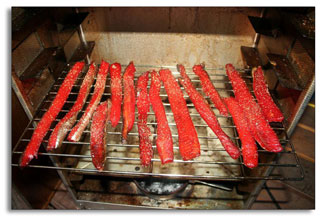|
|
Fish hunterby Ari LeVaux For years, my family’s main source of meat has been deer and elk I’ve shot. It’s a great diet, but it does leave us lacking in the seafood department. I planned to use my spare time in Alaska to secure as much fish as possible, thus diversifying the stash in our freezer. But fishing isn’t cheap up there. I quickly realized that if acquiring fish at a good price per pound is your primary motivation – as opposed to the experience of catching it – you need to make your decisions carefully. Halibut is one of the most valuable fish in the sea, typically fetching $20 to $30 per pound retail. And they can grow very large, regularly topping a hundred pounds. Two-hundred pounders are not unheard of, and specimens between 30 and 100 pounds are common. But statistically, you’re a lot more likely to catch “chickens,” as the small halibut are called. Fishing is always a gamble, and for halibut, out of Valdez in high season, you ante up with a $350 ride on a charter boat. It’s 120 miles round-trip from the sheltered Port of Valdez, through a narrow fjord and past a maze of islands that give way to Prince William Sound. On the other side awaits the Gulf of Alaska. It’s a beautiful ride, but it would be a lot to pay for a couple of chickens. Each fish is roughly half meat in poundage, and you’re allowed two fish per day. If one were so lucky as to land, say, two modest 30 pounders, the 30 pounds of meat they would yield would fetch about $900 at Whole Foods. But when you include the cost of having the fish vacuum-sealed and frozen, which adds $1.40 per pound, and shipping it home overnight express: about $5 per pound, this all makes $900 worth of halibut filet just about the economic break-even point compared to buying it at the store. If halibut fishing is a financial gamble, salmon fishing is a guaranteed economic loss, if slight. Retail salmon is worth only about a third of the price of halibut, and a six-fish daily limit makes it hard to accrue more than 40 pounds of meat per trip. But other than a cheaper boat ride (the salmon are closer to port), the costs of salmon and halibut fishing and processing are virtually identical. Sockeye salmon, caught the previous day in Prince William Sound, was on special for $6 a pound at the Valdez fish store, where halibut costs $18/pound. At 5 a.m., in fierce rain, I walked to the harbor. I found my boat, the Halibut Grove, upon which I had made a reservation through Fish Central, a charter broker in Valdez. We were seven: six passengers and the boat’s captain, a college kid named Seth Grove, who runs the boat for his dad in the summers. Captain Seth was on the verge of canceling the day’s trip because of rough weather out in the gulf, where the big fish hang out. Ultimately he decided to go for it, but by the time we began crossing Prince William Sound, I understood his hesitation. Ocean swells were rolling in from the gulf, which was too rough for fishing, so we stayed in the sound, where the almost-as-big ones hang out. On the way out, we saw whales, porpoises, sea otters, sea lions and a horned puffin. They were cool, but I could not eat them. Even in the relative calm, on the lee side of an island on the edge of the sound, the boat was rocking enough at anchor that staying out of the water was constantly on my mind. Instead, the water came to me. The wind was whipping in off the gulf, blowing a mixture of ocean spray and rain, most of which ran down my face and into my rain gear. Catching halibut on a charter involves doing only two things, but they must be done correctly. The most important of these is finding the right boat, with a captain who knows where the fish are. The other requisite – indeed, the entire art of halibut fishing – is to hang your hook the correct distance above the sea floor: about 8 inches. You drop the hook, letting the line play out until it hits bottom, at which point you reel it back up half a turn. And that’s basically halibut fishing. We started catching them. They’re dark, prehistoric, kind of intimidating looking creatures. I threw back a few chickens before keeping a 20-pounder that ended up being the smallest fish on the boat. We were running out of day, and my gamble was looking like it might be a bust when I caught my second fish. After fighting what was obviously a big fish from about a hundred feet down, we saw a plywood-sized shadow gliding beneath the surface. As we tried to land the fish, it bolted, swimming under the boat, pulling line from the reel while carving a course that entangled several other fishing lines before wrapping all of them around the boat’s propeller. The next thing I knew, Captain Seth had my rod and was leaning over the icy whitecaps, submerging the rod and waving it toward the propeller. He got it untangled without losing the fish, and we landed a 145-pound halibut. The gamble had paid off. The freezer is now full of fresh red meat and white fish. Oh, and I saw some cool people get married. |


